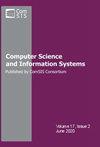Intrusion detection model of internet of things based on deep learning
IF 1.2
4区 计算机科学
Q4 COMPUTER SCIENCE, INFORMATION SYSTEMS
引用次数: 0
Abstract
The proliferation of Internet of Things (IoTs) technology is being seriously impeded by insecure networks and data. An effective intrusion detection model is essential for safeguarding the network and data security of IoTs. In this pa per, a hybrid parallel intrusion detection model based on deep learning (DL) called HPIDM features a three-layer parallel neural network structure. Combining stacked Long short-term memory (LSTM) neural networks with convolutional neural net work (CNN) and SK Net self-attentive mechanism in the model allows HPIDM to learn temporal and spatial features of traffic data effectively. HPIDM fuses the acquired temporal and spatial feature data and then feeds it into the CosMargin classifier for classification detection to reduce the impact of data imbalance on the 23 performance of the Intrusion Detection System (IDS). Finally, HPIDM was experimentally compared with classical intrusion detection models and the two comparative models designed in this paper, and the experimental results show that HPIDM achieves 99.87% accuracy on the ISCX-IDS 2012 dataset and 99.94% accuracy on the CICIDS 2017 dataset. In addition, it outperforms other comparable models in terms of recall, precision, false alarm rate (FAR), and F1 score, showing its feasibility and superiority.基于深度学习的物联网入侵检测模型
物联网(iot)技术的扩散受到网络和数据不安全的严重阻碍。有效的入侵检测模型是保障物联网网络和数据安全的关键。本文提出了一种基于深度学习(DL)的混合并行入侵检测模型HPIDM,该模型具有三层并行神经网络结构。该模型将堆叠长短期记忆(LSTM)神经网络与卷积神经网络(CNN)和SK网自关注机制相结合,使HPIDM能够有效地学习交通数据的时空特征。HPIDM将采集到的时空特征数据融合后,输入到CosMargin分类器中进行分类检测,以减少数据不平衡对入侵检测系统性能的影响。最后,将HPIDM与经典入侵检测模型以及本文设计的两种对比模型进行了实验比较,实验结果表明,HPIDM在ISCX-IDS 2012数据集上的准确率达到99.87%,在CICIDS 2017数据集上的准确率达到99.94%。此外,该模型在召回率、准确率、虚警率(FAR)和F1分数等方面均优于其他可比较模型,显示了其可行性和优越性。
本文章由计算机程序翻译,如有差异,请以英文原文为准。
求助全文
约1分钟内获得全文
求助全文
来源期刊

Computer Science and Information Systems
COMPUTER SCIENCE, INFORMATION SYSTEMS-COMPUTER SCIENCE, SOFTWARE ENGINEERING
CiteScore
2.30
自引率
21.40%
发文量
76
审稿时长
7.5 months
期刊介绍:
About the journal
Home page
Contact information
Aims and scope
Indexing information
Editorial policies
ComSIS consortium
Journal boards
Managing board
For authors
Information for contributors
Paper submission
Article submission through OJS
Copyright transfer form
Download section
For readers
Forthcoming articles
Current issue
Archive
Subscription
For reviewers
View and review submissions
News
Journal''s Facebook page
Call for special issue
New issue notification
Aims and scope
Computer Science and Information Systems (ComSIS) is an international refereed journal, published in Serbia. The objective of ComSIS is to communicate important research and development results in the areas of computer science, software engineering, and information systems.
 求助内容:
求助内容: 应助结果提醒方式:
应助结果提醒方式:


